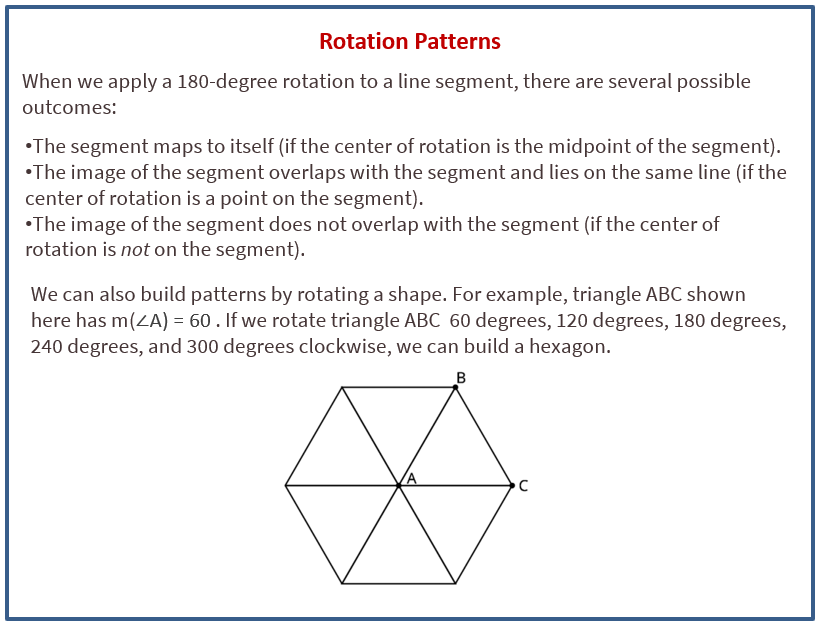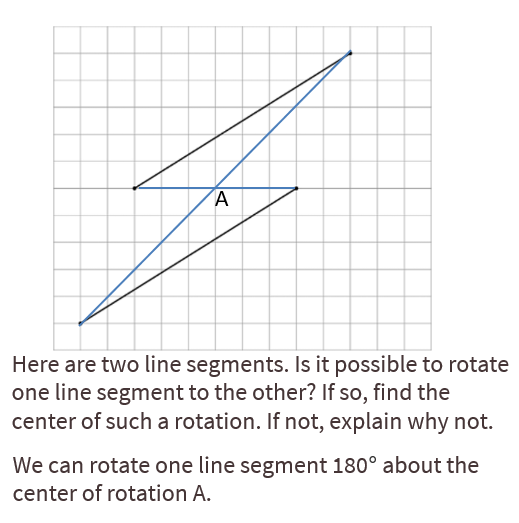Illustrative Mathematics Grade 8, Unit 1, Lesson 8: Rotation Patterns
Learning Targets:
- I can describe how to move one part of a figure to another using a rigid transformation.
Related Pages
Illustrative Math
Grade 7
Lesson 8: Rotation Patterns
Let’s rotate figures in a plane.
Illustrative Math Unit 8.1, Lesson 8 (printable worksheets)
Lesson 8 Summary
The following diagram shows how to move one part of a figure to another using a rigid transformation.

Lesson 8.1 Building a Quadrilateral
Here is a right isosceles triangle:
- Rotate triangle ABC 90 degrees clockwise around B.
- Rotate triangle ABC 180 degrees clockwise around B.
- Rotate triangle ABC 270 degrees clockwise around B.
- What would it look like when you rotate the four triangles 90 degrees clockwise around B? 180 degrees? 270 degrees clockwise?
Lesson 8.2 Rotating a Segment
Create a segment AB and a point C that is not on segment AB.
Open Applet
- Rotate segment AB 180° around point B.
- Rotate segment AB 180° around point C.
Construct the midpoint of segment AB with the Midpoint tool. - Rotate segment AB 180° around its midpoint. What is the image of A?
- What happens when you rotate a segment 180°?
Are you ready for more?
Here are two line segments. Is it possible to rotate one line segment to the other? If so, find the center of such a rotation. If not, explain why not.
Lesson 8.3 A Pattern of Four Triangles
Here is a diagram built with three different rigid transformations of triangle ABC.
Use the applet to answer the questions. It may be helpful to reset the image after each question.
Open Applet
- Describe a rigid transformation that takes triangle ABC to triangle CDE.
- Describe a rigid transformation that takes triangle ABC to triangle EFG.
- Describe a rigid transformation that takes triangle ABC to triangle GHA.
- Do segments AC, CE, EG, and GA all have the same length? Explain your reasoning.
Lesson 8 Practice Problems
- For the figure shown here,
a. Rotate segment CD 180° around point D.
b. Rotate segment CD 180° around point E.
c. Rotate segment CD 180° around point M. - Here is an isosceles right triangle:
Draw these three rotations of triangle ABC together.
a. Rotate triangle ABC 90 degrees clockwise around A.
b. Rotate triangle ABC 180 degrees around A.
c. Rotate triangle ABC 270 degrees clockwise around A. - Each graph shows two polygons ABCD and A’B’C’D'. In each case, describe a sequence of transformations that takes ABCD to A’B’C’D'.
- Lin says that she can map Polygon A to Polygon B using only reflections. Do you agree with Lin? Explain your reasoning.
The Open Up Resources math curriculum is free to download from the Open Up Resources website and is also available from Illustrative Mathematics.
Try out our new and fun Fraction Concoction Game.
Add and subtract fractions to make exciting fraction concoctions following a recipe. There are four levels of difficulty: Easy, medium, hard and insane. Practice the basics of fraction addition and subtraction or challenge yourself with the insane level.

We welcome your feedback, comments and questions about this site or page. Please submit your feedback or enquiries via our Feedback page.
